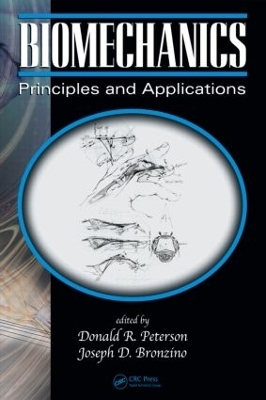
Biomechanics
Principles and Applications, Second Edition
Seiten
2007
|
2nd edition
Crc Press Inc (Verlag)
978-0-8493-8534-6 (ISBN)
Crc Press Inc (Verlag)
978-0-8493-8534-6 (ISBN)
Offers coverage of musculoskeletal mechanics including hard- and soft tissue and joint mechanics and their applications to human function.This book explores several aspects of biofluid mechanics and cover a wide range of circulatory dynamics such as blood vessel and blood cell mechanics and transport.
Traditionally, applications of biomechanics will model system-level aspects of the human body. As a result, the majority of technological progress to date appears in system-level device development. More recently, biomechanical initiatives are investigating biological sub-systems such as tissues, cells, and molecules. Fueled by advances in experimental methods and instrumentation, these initiatives, in turn, directly drive the development of biological nano- and microtechnologies.
A complete, concise reference, Biomechanics integrates coverage of system and sub-system models, to enhance overall understanding of human function and performance and open the way for new discoveries. Drawn from the third edition of the widely acclaimed and bestselling The Biomedical Engineering Handbook, this is a comprehensive, state-of-the-science resource concerning the principles and applications of biomechanics at every level. The book presents substantial updates and revisions from the Handbook’s previous editions, as well as an entirely new chapter introducing current methods and strategies for modeling cellular mechanics. Organized in a systematic manner, the book begins with coverage of musculoskeletal mechanics including hard- and soft tissue and joint mechanics and their applications to human function. Contributions explore several aspects of biofluid mechanics and cover a wide range of circulatory dynamics such as blood vessel and blood cell mechanics and transport.
Other topics include the mechanical functions and significance of the human ear and the performance characteristics of the human body during exercise and exertion. The book contains more than 140 illustrations, 60 tables, and a variety of useful equations to assist in modeling biomechanical behaviors. Incorporating material across the breadth of the field, Biomechanics is a complete, concise reference for the skilled professional as well as an introduction to the novice or student of biomedical engineering.
Traditionally, applications of biomechanics will model system-level aspects of the human body. As a result, the majority of technological progress to date appears in system-level device development. More recently, biomechanical initiatives are investigating biological sub-systems such as tissues, cells, and molecules. Fueled by advances in experimental methods and instrumentation, these initiatives, in turn, directly drive the development of biological nano- and microtechnologies.
A complete, concise reference, Biomechanics integrates coverage of system and sub-system models, to enhance overall understanding of human function and performance and open the way for new discoveries. Drawn from the third edition of the widely acclaimed and bestselling The Biomedical Engineering Handbook, this is a comprehensive, state-of-the-science resource concerning the principles and applications of biomechanics at every level. The book presents substantial updates and revisions from the Handbook’s previous editions, as well as an entirely new chapter introducing current methods and strategies for modeling cellular mechanics. Organized in a systematic manner, the book begins with coverage of musculoskeletal mechanics including hard- and soft tissue and joint mechanics and their applications to human function. Contributions explore several aspects of biofluid mechanics and cover a wide range of circulatory dynamics such as blood vessel and blood cell mechanics and transport.
Other topics include the mechanical functions and significance of the human ear and the performance characteristics of the human body during exercise and exertion. The book contains more than 140 illustrations, 60 tables, and a variety of useful equations to assist in modeling biomechanical behaviors. Incorporating material across the breadth of the field, Biomechanics is a complete, concise reference for the skilled professional as well as an introduction to the novice or student of biomedical engineering.
Donald R. Peterson, Joseph D. Bronzino
Mechanics of Hard Tissue. Musculoskeletal Soft Tissue Mechanics. Joint-Articulating Surface Motion. Joint Lubrication. Analysis of Gait. Mechanics of Head/Neck. Biomechanics of Chest and Abdomen Impact. Cardiac Biomechanics. Heart Valve Dynamics. Arterial Macrocirculatory Hemodynamics. Mechanics of Blood Vessels. The Venous System. Mechanics, Molecular Transport, and Regulation in the Microcirculation. Mechanics and Deformability of Hematocytes. Mechanics of Tissue/Lymphatic Transport. Modeling in Cellular Biomechanics. Cochlear Mechanics. Vestibular Mechanics. Exercise Physiology. Factors Affecting Mechanical Work in Humans. (New Material TBA).
| Erscheint lt. Verlag | 25.9.2007 |
|---|---|
| Zusatzinfo | 59 Tables, black and white; 200 Illustrations, color; 143 Illustrations, black and white |
| Verlagsort | Bosa Roca |
| Sprache | englisch |
| Maße | 189 x 246 mm |
| Gewicht | 839 g |
| Themenwelt | Studium ► 1. Studienabschnitt (Vorklinik) ► Physiologie |
| ISBN-10 | 0-8493-8534-2 / 0849385342 |
| ISBN-13 | 978-0-8493-8534-6 / 9780849385346 |
| Zustand | Neuware |
| Haben Sie eine Frage zum Produkt? |
Mehr entdecken
aus dem Bereich
aus dem Bereich


